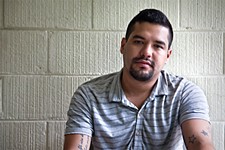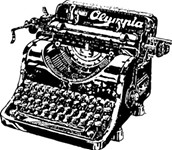Prison Buff
Peeking Behind the Curtain of Incarceration
By Amanda Eyre Ward, Fri., April 6, 2001

Shakespeare Behind Bars: The Power of Drama in a Women's Prison
by Jean TrounstineSt. Martin's Press, 208 pp., $23.95
The Wrong Man: A True Story of Innocence on Death Row
by Michael MelloUniversity of Minnesota Press, 552 pp., $29.95
Going Up the River: Travels in a Prison Nation
by Joseph T. HallinanRandom House, 320 pp., $24.95
Hi, my name is Amanda, and I am obsessed with prisons. There: I've said it. When I go to a dinner party, I corner the lawyer who knows about Penal Code. When my husband comes home early, he catches me in a bubble bath with true crime paperback books about incarcerated murderers, preferably female. I am writing a novel about women on death row. I have read every page of Norman Mailer's The Executioner's Song.

My obsession might be shocking to some (my mother, for example, whose obsession is shoes), but I have been surprised by the number of people who share my fascination. Over cocktails with the girls from work, I begin chatting about prison food (you can have a corn dog in prison, but you cannot have a corn dog on a stick); while there are some who stare into their margaritas or look at me with barely disguised alarm, more than one listens carefully, shakes her head in awe. For every time my younger cousin asks me if I'm still working on my "sicko book," there's a family dinner where someone (generally after some wine) asks me to tell them everything I know about death row.
What is it about prison that people like me find intriguing? Perhaps it is the notion of punishment, of how such a thing as a life of punishment is designed and (pardon me) executed. Maybe it is the very fine line that separates the incarcerated and the free, the "good" and the "bad." It could be the very definition of freedom. I don't think I am the only person who has thought, on a very bad day, that a small cot, a stack of books, and some time on my hands might not be the worst thing in the world.
What intrigues me is life inside prison walls. How does a person find family, community, joy, and forgiveness, when they are forced to spend each hour inside a set of walls designed specifically to keep them from doing so? More evidence that I am not alone in my fascination: My editor at The Austin Chronicle claims there is such a thing as "prison lit."
Shakespeare Behind Bars, by Jean Trounstine, is an account of Trounstine's 10 years directing plays behind the bars of the Framingham Women's Prison outside of Boston. From the countless number of women Trounstine worked with during those 10 years, she fashions six composite inmates to show how the written word and the power of performance have changed their lives. The book is not only readable, but a powerful argument for rehabilitative efforts in prisons. (Trounstine eventually had her funding taken away, and no longer works in the prison.)
Trounstine's book is filled with vibrant characters. There's Dolly, a battered woman convicted as an accessory to murder, who first brings up the idea of doing a play. Trounstine remarks that, "here, in the loneliest place I know, I can feel her wanting to stretch, to be more than she is." There's Bertie, a Jamaican woman convicted of killing her own daughter. When Bertie first reads a story aloud, Trounstine notes, "If writing earns respect and telling one's story builds connections, I realize the power theater might have in this place." Although Bertie misses classes and sinks into depression from time to time, she volunteers to speak with visitors to the prison, telling Trounstine, "I just want them to accept that I am a person." After her performance as Bianca in the prison performance of The Merchant of Venice, Bertie writes in her journal, "I know now I am somebody."

Rhonda, a college-educated woman who eventually serves her entire sentence and is let free, says to a friend in Trounstine's earshot, "This play is controlling me better than all the tricks the Department of Corrections has up its sleeve." And Mamie, who is dying of AIDS, begs Trounstine to invite the author Elie Wiesel to class after they read Night, Wiesel's memorable account of surviving concentration camps during the Holocaust. Mamie says, "I need to find out how he got back his faith in God."
This book is a persuasive account of rehabilitative therapy that occasionally worked, but the fact that the characters are not identifiable individuals is problematic. For example, when Trounstine writes about checking in with her characters in later years, the reader has to wonder exactly how that happened. Call me a sucker, though: I got teary when Mamie mused "We were stars" about the performance of Merchant of Venice.
The Wrong Man: A True Story of Innocence on Death Row by Michael Mello, a lawyer who has worked on the cases of Ted Bundy and Theodore Kaczynski, examines the system of law and red tape that can land a man on death row for a crime he did not commit. In 1983, Mello became the lawyer for "Crazy Joe" Spaziano, a member of a biker gang sentenced to death in 1976 for the rape and murder of Laura Lynn Harberts. Because of Mello and a team of journalists from the Miami Herald, Spaziano remains alive today but is not yet free, despite the fact that the key witness against him has now recanted his testimony. Spaziano's letters to his lawyer are reprinted here, and make the case particularly moving. In Mello's words, "The lesson of the 'Crazy Joe' case is that innocent people are condemned to die." Mello's attempt to provide an exhaustive account of the case is admirable, but as a reader I found myself dismayed by a rambling, often boring, narrative. The inclusion of every memorandum and minutiae becomes repetitious and tiring. While Spaziano's incarceration and death penalty are disturbingly real, Mello's messy book does not do Spaziano the justice a tighter, more readable book might have done.
Of these three books, Going Up the River: Travels in a Prison Nation by Pulitzer Prize-winning journalist Joseph Hallinan is by far the best. The book begins with a quote from Frederick Howard Wines, author of An Historical Sketch of the Rise of the Penitentiary System (1895): "One final thought. Too much use is made of the prison." Hallinan then spends the remainder of his graceful book proving that Wines' words are still valid. Hallinan is a self-proclaimed "prison buff." (When he admits this to a prison guard, the man shakes his head and says, "You ever thought about girls?")
Hallinan travels around the United States talking with prison officials, inmates, local politicians, and even townspeople to see "how the merger of punishment and profit [is] reshaping this country."

Hallinan's lens is wide; he is interested in why small American towns that once wanted nothing to do with prisons are now courting them. And he spends most of his time in Texas. "Much of this book takes place in Texas," Hallinan explains, "... because Texas is to the prison culture of the 1990s what California was to the youth culture of the 1960s: it's where it's happening. Texas has more prisons than any state in the country and imprisons more of its people, per capita, than any state except Louisiana. Instead of Berkeley, Texas has Beeville ... today, a prison stands where the Navy pilots once landed jets, and the town's people are happy. 'I love it, I really do,' said Dave Stafford, who quit his job as a public school teacher to work at one of the town's two prisons."
Hallinan also looks inside prison walls. He writes about the fact that American prisons, which once considered the possibility that inmates might rehabilitate and prove useful to society, have become profit-making enterprises with little room for rehabilitation, since incarceration, pure and simple, is much cheaper than attempts to change prisoners. Hallinan visits the ruins of the Eastern State Penitentiary in Philadelphia, which was built in 1829 by the Quakers, where prisoners were left in solitary confinement for 23 hours a day, inducing depression and psychosis in many of the inmates.
Lest readers think that we have come a long way, Hallinan traces the history of American prisons, which have arguably come back full circle. The rise of rehabilitative attempts has cratered to the economic profitability of leaving prisoners in solitary confinement, or in front of a television all day. "Warden after warden," writes Hallinan, "would recite to me not the recidivism rates of the men who had left their prisons (this was seldom measured), nor the educational levels of the men still there (most are high school dropouts), nor any other indicator of 'rehabilitation.' But every warden I met could tell me his average daily inmate cost." Often, Hallinan notes, inmates are not even given work to do because it is cheaper, if more dangerous, to have them idle. Crushing big rocks into smaller ones doesn't do that much for society.
As American drug laws grow stiffer, and more people are given longer sentences in prison, the prison industry thrives. Hallinan exposes the individuals behind the statistics, and in doing so makes the issues not only real, but heartbreaking. He speaks with Alva Mae Groves, a "toothless great-grandmother" sentenced for 24 years in prison for selling crack out of her mobile home. Hallinan leaves Alva Mae's prison "wondering how we had come to the point where we stick seventy-six year-old ladies in prison for twenty-four years and call it a good idea."
Hallinan leaves the reader with shards of hope, though: Some prisoners have found a sort of redemption. He writes that "the elements of rehabilitation seemed clear to me: a job, a faith, a family. Those same things that anchor us in the outside world also hold on the inside. ... A crime, at its root, is not an intellectual failure but a moral one."
The fact is that people do not want to explore the world behind America's prison walls. When a friend read the start of my novel, set on death row in Gatesville, Texas, he said that he couldn't stop thinking, as he ate dinner, or went to work or the gym, that people were spending every hour locked up. He didn't want to think about these people, as most of us don't. It takes a true prison buff like Hallinan to make us stop what we are doing in the busy hours of our lives and think about the issues of crime and punishment in America. Hallinan is a seasoned journalist, and his compelling mix of facts and personal interviews proved more moving than either Mello's tirade of law dogma or Trounstine's overly saccharine emotional appeals. I don't know about Trounstine or Mello, but Hallinan could certainly make every one of my friends put down their margaritas and take notice. ![]()








